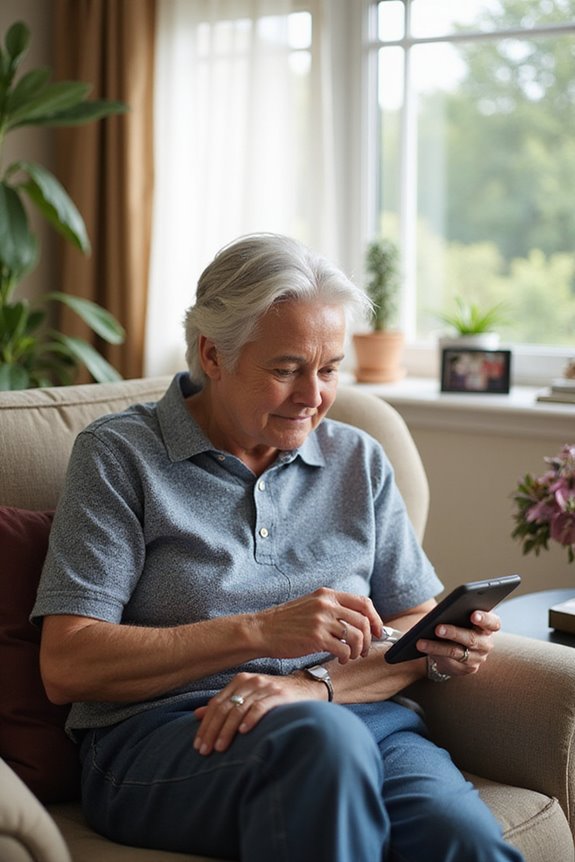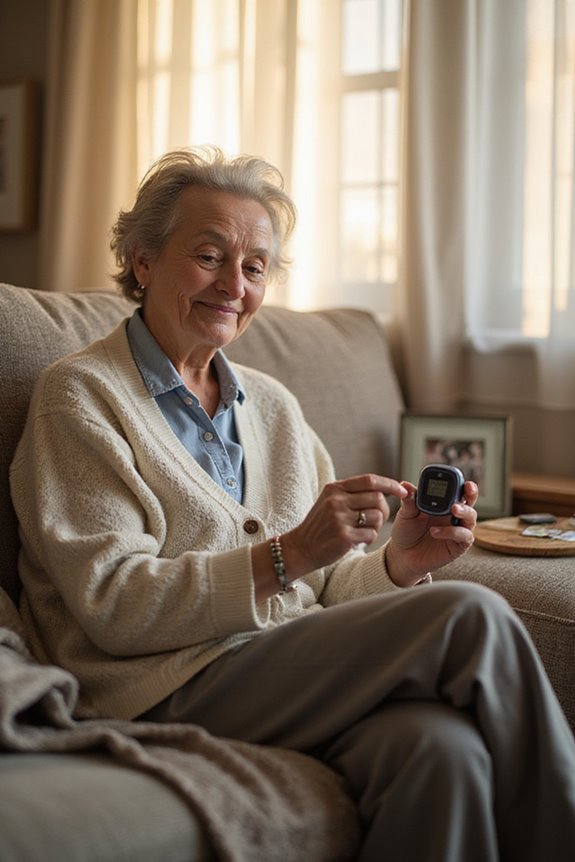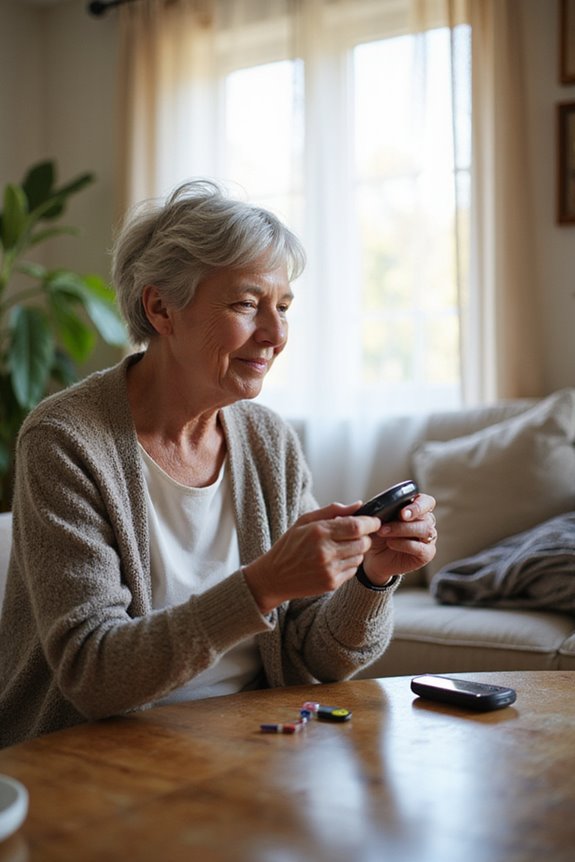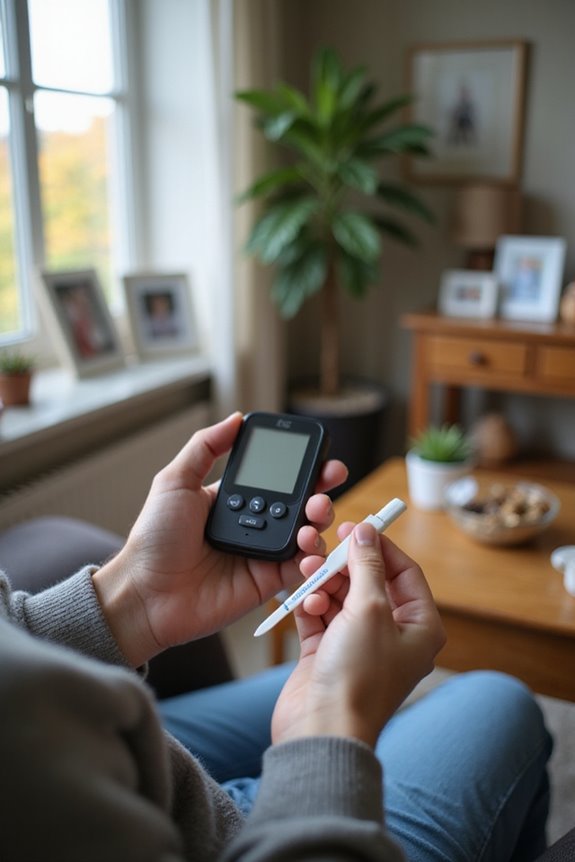Freestyle Libre sensors are key instruments in diabetes management, featuring a flash glucose monitoring system. Their dimensions are 5 mm in height and 35 mm in diameter, with a weight of approximately 5 grams. They provide continuous glucose data, measuring levels every minute, with a lifespan of up to 14 days. The sensors are factory calibrated and require compatible devices running Android 8.0+ or iOS 13.2+. For further insights into their functionality and support, additional information is available.
Key Takeaways
- Freestyle Libre sensors are factory calibrated and do not require additional calibration for accurate glucose monitoring.
- Each sensor can be worn for up to 14 days, with proper skin preparation for better adhesion.
- The recommended placement site is the back of the upper arm, avoiding scars or moles.
- Sensors are compatible with devices running Android 8.0+ or iOS 13.2+, including various popular smartphone models.
- Real-time data sharing features enhance communication between patients and healthcare providers, promoting better diabetes management.
What Are the Key Features of the Freestyle Libre Sensor?
The Freestyle Libre sensor is engineered with several key features that enhance its functionality and usability for continuous glucose monitoring.
Sensor Specifications
- Size: 5 mm height, 35 mm diameter
- Weight: Approximately 5 grams
- Battery: Silver oxide
Operational Capabilities
- Water Resistance: Immersible up to 1 meter for 30 minutes
- Temperature Range: 10°C to 45°C
- Humidity Tolerance: 10% to 90% (non-condensing)
User Experience
- Placement: Recommended on the back of the upper arm
- Calibration: Factory calibrated, no additional calibration required
- Sensor Life: Up to 14 days of continuous use
This advanced sensor technology facilitates seamless glucose monitoring, aligning with the needs of users seeking reliable diabetes management solutions. Additionally, its non-invasive design allows for greater comfort compared to traditional blood glucose meters.
How Does the Sensor Work and What Data Does It Provide?
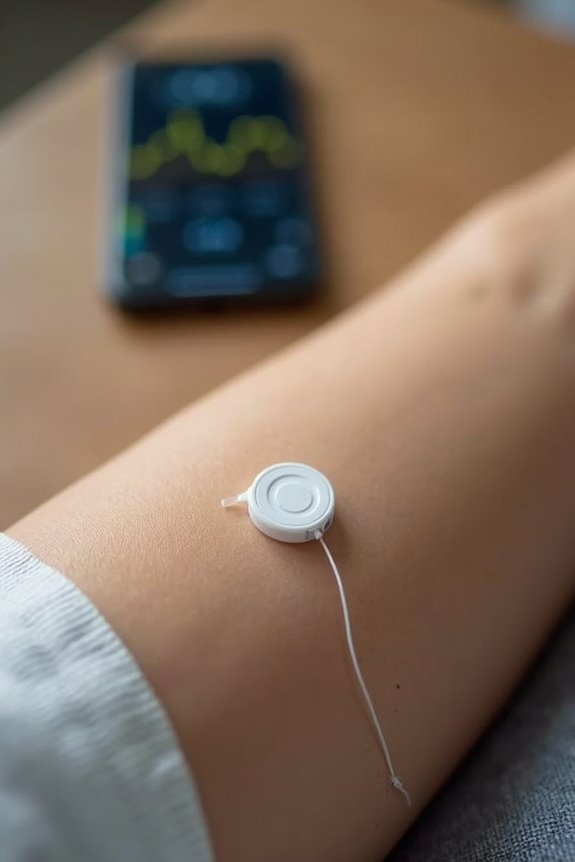
Utilizing innovative technology, the Freestyle Libre sensor operates by employing a thin, flexible filament inserted just beneath the skin, which continuously monitors glucose levels in the interstitial fluid.
Sensor Functionality
- The sensor utilizes flash glucose monitoring, measuring glucose every minute and storing data automatically.
- It provides non-invasive glucose readings without the need for fingerstick calibration.
- Users can scan the sensor anytime for real-time glucose levels.
Data Interpretation
- The sensor generates ambulatory glucose profiles, helping users identify hypoglycemia and hyperglycemia episodes.
- Continuous data collection allows for trend analysis, revealing day-to-day patterns essential for effective treatment planning.
- Glucose variability and trends are accessible, supporting informed decisions in diabetes management.
What Is the Recommended Wear Duration for the Sensor?
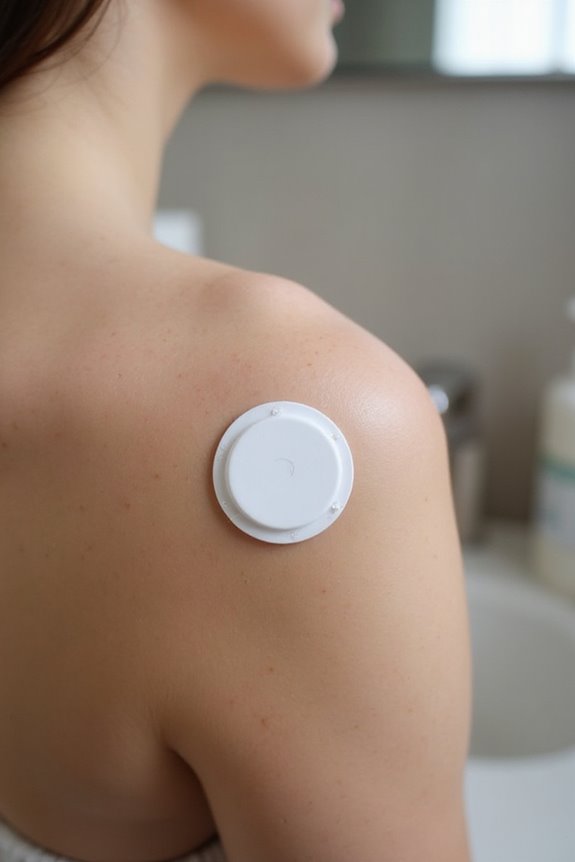
Recommended wear duration for Freestyle Libre sensors is a key aspect of their functionality and user experience. These sensors generally provide a wear time of up to 15 days, depending on the model. For instance, the Freestyle Libre 3 Plus Sensor offers a full 15-day duration.
Wear Tips for Ideal Sensor Longevity:
- Maintain clean, dry skin during application to enhance adhesion.
- Use non-moisturizing, fragrance-free soap and an alcohol wipe before sensor placement.
- Check remaining wear time using connected devices like the t:slim X2 insulin pump or mobile app to prevent unnoticed expiration.
- Replace sensors immediately upon reaching the recommended wear time to guarantee uninterrupted glucose monitoring.
Following these guidelines helps users maximize sensor lifespan while guaranteeing accurate glucose readings.
How Is the Sensor Applied and Where Should It Be Placed?
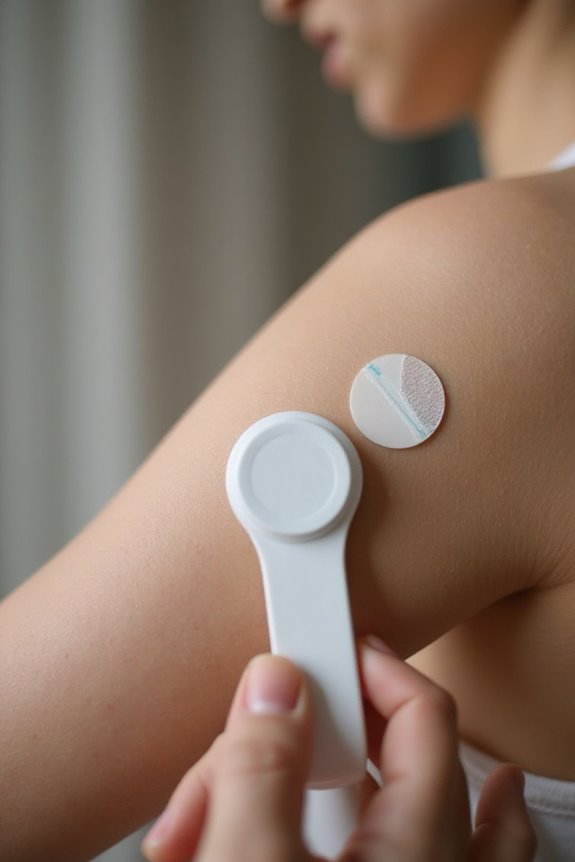
Applying the Freestyle Libre sensor requires careful preparation and precise technique to secure peak performance and accuracy.
Sensor Application
- The recommended site for sensor application is the back of the upper arm.
- Clean the area with non-moisturizing, fragrance-free soap, followed by an alcohol wipe. Allow it to air dry.
- Avoid scars, moles, or areas with body hair.
Placement Tips
- Rotate sensor sites between applications to minimize skin irritation.
- Make sure the skin is free from lotions or oils for best adhesion.
- Align the sensor applicator correctly, press firmly, and discard used components responsibly.
What Devices Are Compatible With the Freestyle Libre Sensor?
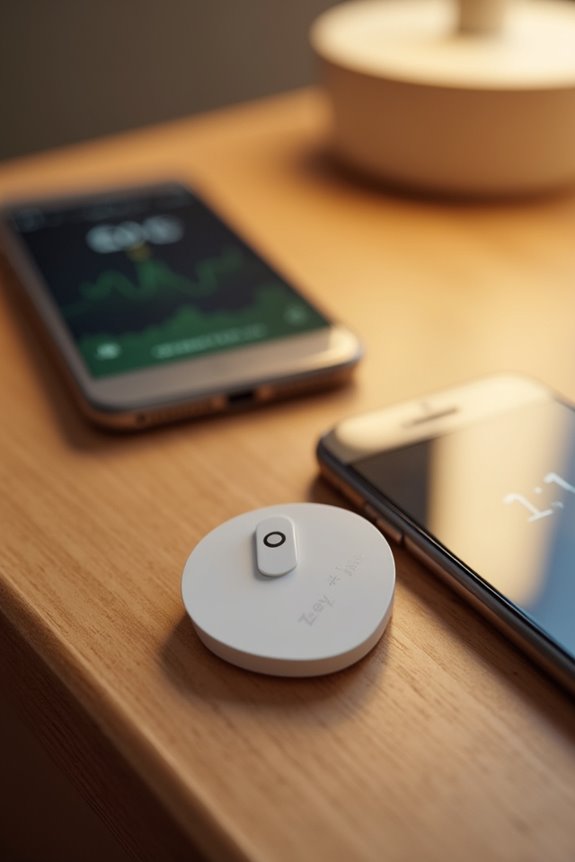
Understanding the compatibility of devices with the FreeStyle Libre sensor is vital for effective glucose monitoring.
Device Compatibility Overview
- The FreeStyle Libre sensors utilize NFC technology and require devices to run Android 8.0+ or iOS 13.2+.
- Compatible Android devices include:
- Samsung Galaxy (S10-S23, Note 10/20)
- Google Pixel (4+)
- OnePlus (6+)
- Xiaomi (Redmi Note 9, 10, 11)
- Compatible Apple devices encompass iPhones from 7 to 15 Pro Max.
App Software Compatibility
- The FreeStyle LibreLink app is required for data reading.
- NFC and Bluetooth access are vital for functionality.
Device Limitations
– Confirm devices are updated, as compatibility may vary with sensor versions and app updates.
How Accurate Are the Glucose Readings From the Sensor?
How accurate are the glucose readings from the FreeStyle Libre sensor? The accuracy of the FreeStyle Libre sensors varies by model.
- For the original FreeStyle Libre, the mean absolute relative difference (MARD) is 11.4% in adults and 13.9% in children compared to capillary blood glucose.
- The FreeStyle Libre 3 boasts a notably improved MARD of 7.8% compared to YSI references, with 93.2% of readings within ±20 mg/dL or ±20%.
Sensor calibration is not required for the FreeStyle Libre 3, enhancing user convenience. Accuracy remains stable despite factors such as age or body mass index, although glucose variability and conditions like hypoglycemia may temporarily reduce accuracy. Overall, these sensors provide a reliable option for continuous glucose monitoring. Additionally, monitoring accuracy is essential for effective diabetes management, ensuring users can trust their glucose readings.
What Should I Know About Sensor Replacement and Maintenance?
Proper sensor replacement and maintenance are essential components for ensuring the accuracy and longevity of FreeStyle Libre glucose monitoring systems.
Replacement Timing
- Freestyle Libre 3 sensors should be replaced every 14 to 15 days to maintain accurate readings.
- Delaying replacement can lead to compromised glucose data and potential skin irritation.
Sensor Maintenance
- Clean the skin with non-moisturizing soap and alcohol wipes prior to application.
- Monitor the sensor site daily for signs of irritation, such as redness or itching.
- Rotate sensor application sites to allow skin healing and minimize allergic reactions.
Are There Any Restrictions or Precautions When Using the Sensor?
Are there significant restrictions or precautions when utilizing FreeStyle Libre sensors? Yes, adherence to specific usage guidelines and safety measures is essential for effective functionality.
Age and User Restrictions:
- Approved for children aged 4 and older.
- Intended solely for insulin-dependent diabetes patients.
- Not for multi-user application due to data misinterpretation risks.
Medical Interference:
- Avoid use during MRI, CT scans, or diathermy.
- Wait one hour post-MRI for accurate function; no wait for CT or X-ray.
Application Precautions:
- Clean the application site thoroughly.
- Only apply on the back of the upper arm, avoiding scars or moles.
Medication Interactions:
– Limit Vitamin C intake to under 500 mg/day to prevent false readings.
These precautions guarantee safety and accuracy in glucose monitoring.
How Can I Access My Glucose Data and Set Alerts?
Accessing glucose data and setting alerts is essential for effective diabetes management. Users can achieve glucose access through the FreeStyle LibreLink app, which syncs readings to LibreView, a secure cloud-based platform. This enables users to view reports detailing glucose trends and statistics, enhancing informed decision-making.
To set alert configurations, individuals can customize notifications in the LibreLink app for high or low glucose levels. Alerts are adjustable based on personalized target ranges defined by healthcare providers, facilitating proactive management. Family members may also receive alerts via the LibreLinkUp app, promoting thorough monitoring.
With real-time data sharing to healthcare professionals, patients can enhance their management strategies effectively, fostering a supportive community around their health journey.
Frequently Asked Questions
Can I Wear the Sensor While Swimming or Exercising?
While swimming or exercising, users should adhere to swimming precautions and exercise tips. Properly securing the sensor enhances durability, ensuring accurate readings and confidence during activities. Regular checks on sensor integrity are essential for peak performance.
How Does the Sensor Detect Interstitial Fluid?
The sensor functionality relies on a tiny filament that detects glucose measurement through interaction with interstitial fluid. This continuous process guarantees users stay informed about their glucose levels, fostering a sense of community and support in diabetes management.
What Happens if the Sensor Gets Wet?
When the sensor gets wet, its moisture resistance may weaken, risking internal damage and inaccurate readings. Users should guarantee sensor durability by avoiding prolonged exposure to water, adhering to guidelines for ideal performance and attachment.
Are There Any Side Effects From Using the Sensor?
Concerns about side effects from sensor placement often include skin irritation, experienced by some users. Mild reactions like redness and itching may occur, but they are typically manageable and do not affect overall sensor performance.
Can I Share My Sensor Data With Healthcare Providers?
Data sharing with healthcare providers enhances collaboration, allowing for real-time access to glucose patterns. This fosters a supportive environment where patients and providers work together, optimizing diabetes management through informed decisions based on extensive data insights.

